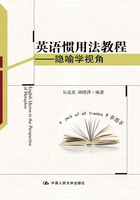
使用说明
1.The association vehicles are arranged from the most familiar to the least, i.e., from human body, food, clothes, spatial relationship, nature including natural objects, color, fruits and plants, and animals and other vehicles, to social culture excluding food and clothes (time idioms considered to be a prelude). Then the detailed items are put together alphabetically, which can be found in the contents. Some idioms containing two vehicles may appear twice in the book or just in the place of the more important vehicle.
2.The idioms are underlined but the proverbs not.
3.Some vehicles are put together due to their close relationship.
4.Some abbreviations are used: sl. stands for slang expressions, fml. for formal style, infml. for informal style, n. for nouns, adj. for adjectives, v. for verbs,adv.for adverbs,conj.for conjunctions,prep.for prepositions and ref.for reference.
5.Bilingual presentation of idioms is offered in the Appendix alphabetical-ly, based on the first word of English idioms. Idioms in nominal, prepositional, adverbial and verbal nature are listed directly, while those in adjective nature or in the passive form are in the form of “be+idioms.” Therefore, “bullheaded” and“taken by the ears” are found in “be bullheaded”/“be taken by the ears” respective-ly. If semi-colons and commas appear in Chinese explanations simultaneously,the former means different usage, while the latter synonyms, such as in “see the light出生;恍然大悟,茅塞顿开.”
Proverbs are characterized by the capital letters at the beginning and full stops in the end.